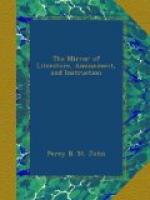In the year 1665, that part of the ground now called Bunhill (originally Bonhill) Field, was set apart as a common cemetery, for the interment of such bodies as could not have room in their parochial burial-grounds in that dreadful year of pestilence. However, not being made use of on that occasion, a Mr. Tindal took a lease thereof, and converted it into a burial-place for the use of Dissenters. It was long called Tindal’s Burial-place. Over the west gate of it was the following inscription:—“This church-yard was inclosed with a brick wall at the sole charges of the city of London, in the mayoralty of Sir John Lawrence, Knt., Anno Domini 1665; and afterwards the gates thereof were built and finished in the mayoralty of Sir Thomas Bloudworth, Knt., Anno Domini, 1666.”
The fen or moor (in this neighbourhood), from whence the name Moorfields, reached from London-wall to Hoxton; the southern part of it, denominated Windmill Hill, began to be raised by above one-thousand cart-loads of human bones, brought from St. Paul’s charnel-house in 1549, which being soon after covered with street dirt from the city, the ground became so elevated, that three windmills were erected on it; and the ground on the south side being also much raised, it obtained the name of The Upper Moorfield.
The first monumental inscription in Bunhill-fields is, Grace, daughter of T. Cloudesly, of Leeds. Feb. 1666.—Maitland’s Hist. of London, p. 775.
Dr. Goodwin was buried there in 1679; Dr. Owen in 1683; and John Bunyan in 1688.
Park-place, Highbury Vale.
J. H. B.
* * * * *
SUPPOSED ORIGIN OF MEZZO-TINTO.[1]
Mezzo-tinto is said to have been first invented by Prince Rupert, about the year 1649: going out early one morning, during his retirement at Brussels, he observed the sentinel, at some distance from his post, very busy doing something to his piece. The prince asked the soldier what he was about? He replied, the dew had fallen in the night, had made his fusil rusty, and that he was scraping and cleaning it. The prince, looking at it, was struck with something like a figure eaten into the barrel, with innumerable little holes, closed together, like friezed work on gold or silver, part of which the fellow had scraped away. The genie second en experiences (says Lord Orford), from so trifling an accident, conceived mezzo-tinto. The prince concluded, that some contrivance might be found to cover a brass plate with such a ground of fine pressed holes, which would undoubtedly give an impression all black, and that, by scraping away proper parts, the smooth superfices would leave the rest of the paper white. Communicating his idea to Wallerant Vaillant, a painter, they made several experiments, and at last invented a steel roller with projecting points, or teeth, like a file, which effectually produced the black ground; and which, being scraped away or diminished at pleasure, left the gradations of light. Such was the invention of mezzo-tinto, according to Lord Orford, Mr. Evelyn, and Mr. Vertue.




